Glacial grooves, also called glacial striations, were first recognized as the result of a moving glacier in the late 1700s by Swiss alpinists. They were also one of the first to realise that if they were visible today, then the glaciers must also be receding.

Ice, however, is not hard enough to cut through a rock. It’s the rock fragments and sand grains embedded underneath the glacier that provide the abrasive power to cut trough-like glacial grooves. The finer sediments in the base of the moving glacier further scour and polish the bedrock surface, forming a glacial pavement.
The glacial grooves on the north side of Kelley’s Island are the largest easily accessible such grooves in the world. They were scoured into solid limestone bedrock about 18,000 years ago by the great ice sheet which covered part of North America. This impressive groove is 400-feet long, 35-feet wide, and up to 10-feet deep. The ice which created these grooves were probably hundreds of feet thick and flowed from the north in what is now the Lake Erie basin. The grooves were under several feet of soil before they were dug out in the 1970s.
At one time Kelley's Island had a much larger glacial groove area with grooves over 2,000 feet in length. It was called the “Great Grooves”. Unfortunately, active quarrying in the area destroyed most of the grooves. The remaining grooves are now protected and fenced in, although open for public. The old rock quarry is still visible behind the Glacial Grooves State Memorial.






Source
